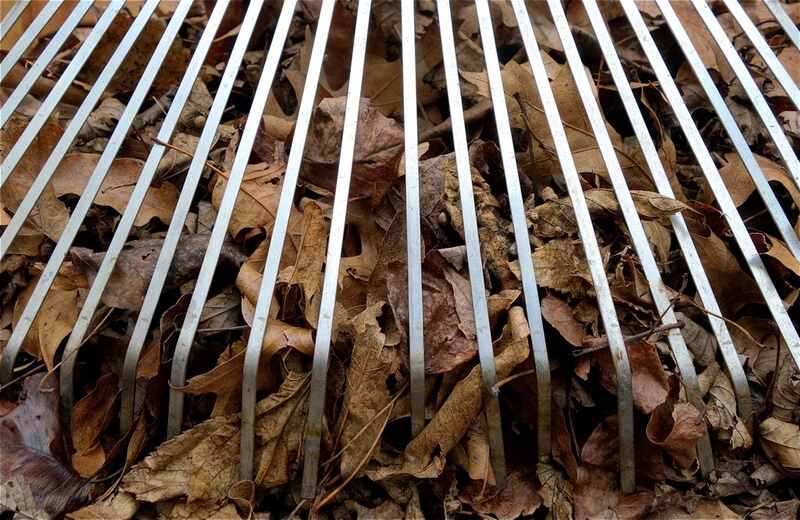
Fallen leaves are beautiful to look at but a pain for homeowners to clean up, especially when they get into hard-to-reach areas like gutters or perennial beds. When autumn leaves get into your flower beds, you want to get them out easily and quickly. Here’s how to remove leaves from mulch and flower beds.
How to Remove Leaves From Mulch and Flower Beds
1. Use Your Hands

If you have a lot of trees in your yard, chances are you have lots of leaves in your flower beds. To remove leaves from delicate plants, grab your gardening gloves and a kneeling pad, and get to work. Raking isn’t going to work for this delicate operation. Instead, pick the leaves off by hand and pile them next to your garden beds where you can mulch them into the lawn later.
2. Light Raking

Your standard leaf rake is too cumbersome for raking leaves from mulch. You’ll need a narrow rake to get in there between your plants and loosen up all the debris that’s settled. Be gentle. Some leaves may be wet and stick to the mulch or wood chips. A hand rake or shrub rake may work well to remove leaves in tight spaces around plants.
3. Use A Leaf Blower or Vacuum

Leaf Blower
If there’s enough space between your plants, you could buy a leaf blower to save time. However, don’t use too much force. Remember, this is a delicate operation. Try to corral the leaves to the center of the row, or else the leaves will get stuck in your plants, creating more work for you.
Angle the blower so it pushes the air over the surface of your mulch, not directly at it. This keeps the mulch, topsoil, and chips from blowing away. There may be a little wind erosion, but nothing you can’t fix by raking it back into place.
Once you’ve blown out most of the leaves, it’s time to get back in there with your hands or a rake and remove any stragglers. Then, you can either put them in your compost pile or your city’s green waste bin. Remember, leaves make a great source of free mulch and fertilizer, so don’t let them go to waste.
Leaf Vacuum/Mulcher
Another option for getting leaves out of your mulch is to use a leaf vacuum/mulcher. Like the blower, vacuums can help with eliminating leaves from mulch. The difference is that the vacuum uses suction instead of blowing power. With a vacuum, you’ll also have to take care when using it to avoid sucking mulch, sticks, or rocks from your beds.
If you happen to suck up something other than leaves, these foreign objects may clog your leaf vacuum or dull the blades. To minimize sucking in additional items besides leaves, keep the vacuum on a low level of suction.
4. Create a Leaf Barrier

If you are looking for an easier way to keep leaves out of your mulch bed, it may be best to install a leaf barrier. This may not get rid of leaves that are in your mulch bed, but it will certainly keep them out in the future. It will also minimize the amount of labor you have to do. Who doesn’t like less work to do?
To create a leaf barrier, lay landscape fabric on top of your mulch in early fall. As autumn leaves fall on your mulch, the leaf fabric will keep it from mixing with the mulch. By the end of the season, you can simply pull up the landscape fabric and get rid of the leaves or add them to your compost pile.
Tools and Materials
- Gloves: When using a leaf blower or vacuum, it is a good idea to protect your hands with gardening gloves. This is also important if you plan to remove the leaves using your hands.
- Protective gear: When operating a leaf blower or vacuum, it is a good idea to wear the proper protective gear, such as eye and ear protection.
- Dust mask (particularly if you have allergies): Besides protective gear, it is a good idea to cover your face with a mask, particularly if you suffer from allergies or other respiratory illnesses.
- Fresh mulch:. Be prepared to replace old mulch with new mulch if it is over a year old. How much does mulch cost? Expect to pay from $2 to $5.50 per bag or from $17 to $68 per cubic yard for mulch.
FAQ About Removing Leaves from Flower Beds
Set the leaf blower at a low speed to remove the layer of leaves but avoid blowing the mulch and organic matter all around.
The average leaf blower costs $149 but ranges from $17 to $619 depending on the power source (electric, gas, or battery). Shop around to get the best leaf blower for your lawn.
When possible, try to use your leaf blower or vacuum on dry leaves instead of wet leaves. This makes the task easier. It also keeps shredded leaves and dead leaves from clogging up your equipment.
Yes. Unfortunately, a leaf vacuum will remove just about anything in its path like a traditional vacuum cleaner. To avoid sucking up your mulch, you may have to use the blower to create a pile of leaves. Then, use the leaf vacuum to shred them before you add them to your compost bin.
Need help tending to your lawn or flower beds? Contact a local landscape professional near you to take this tiresome chore off your weekend to-do list.
Main Image Credit: Pxhere / CC0 1.0